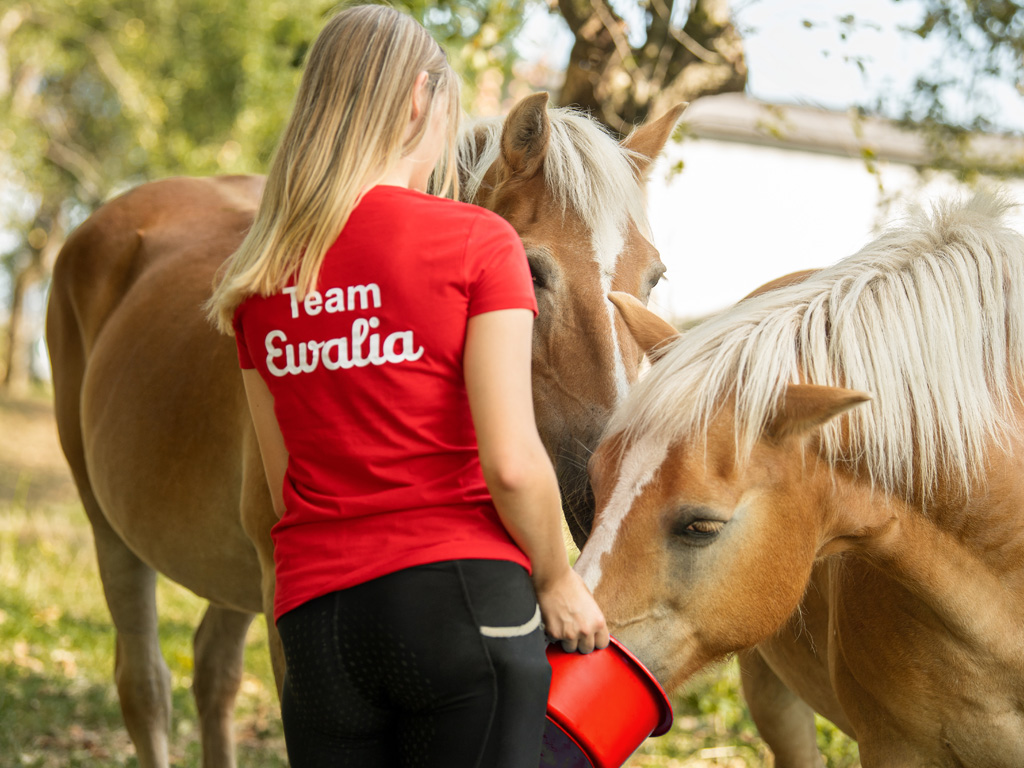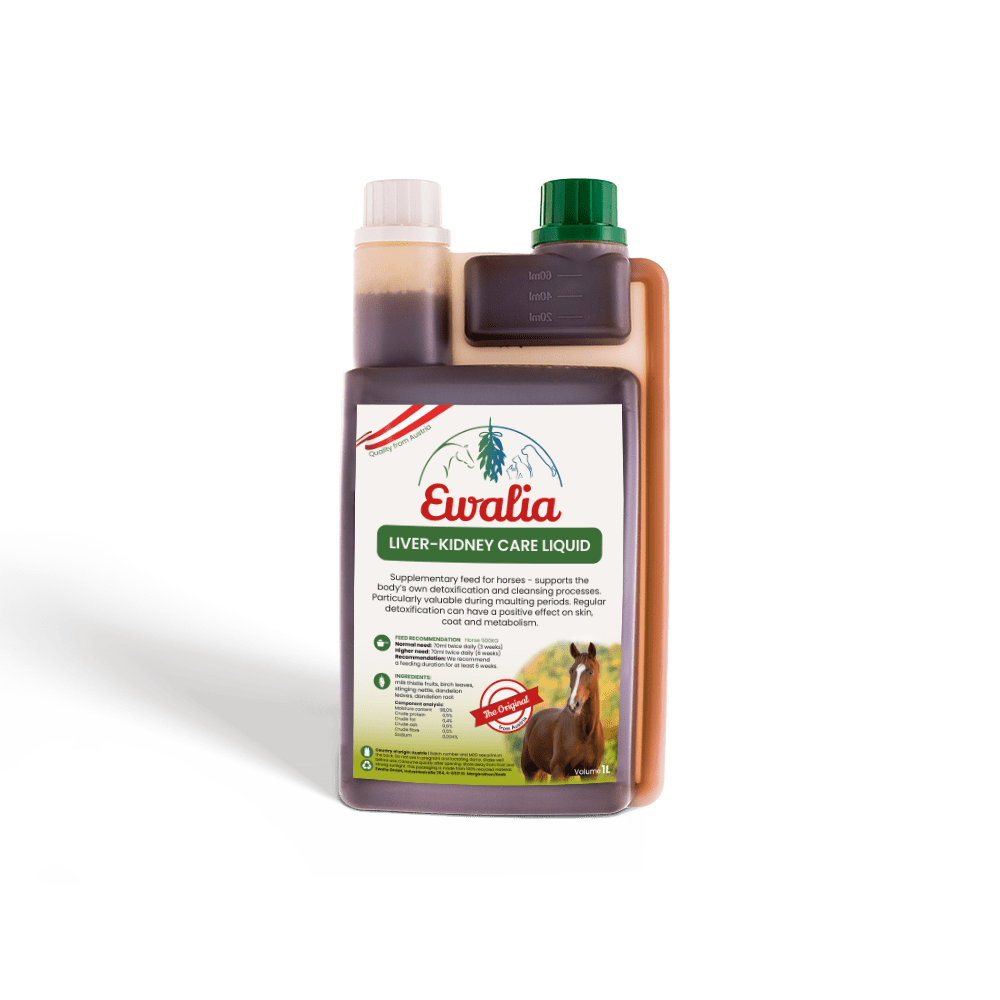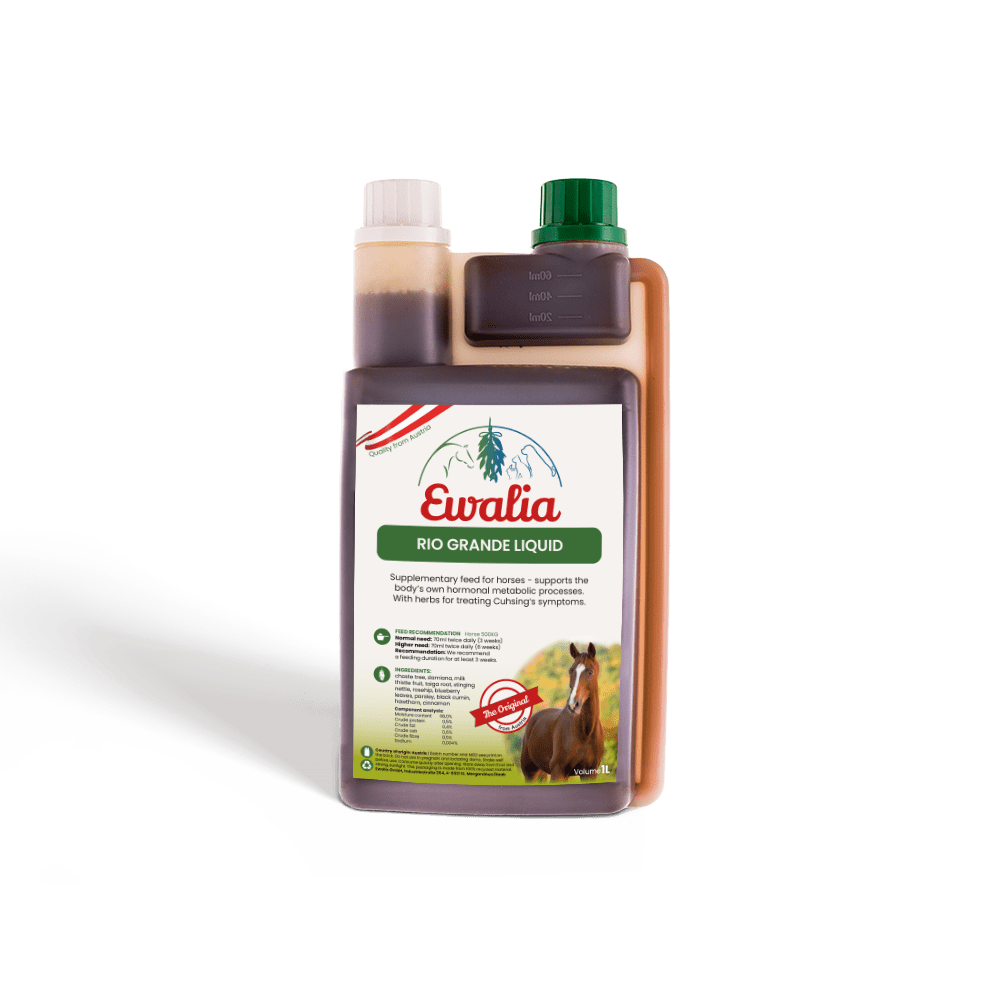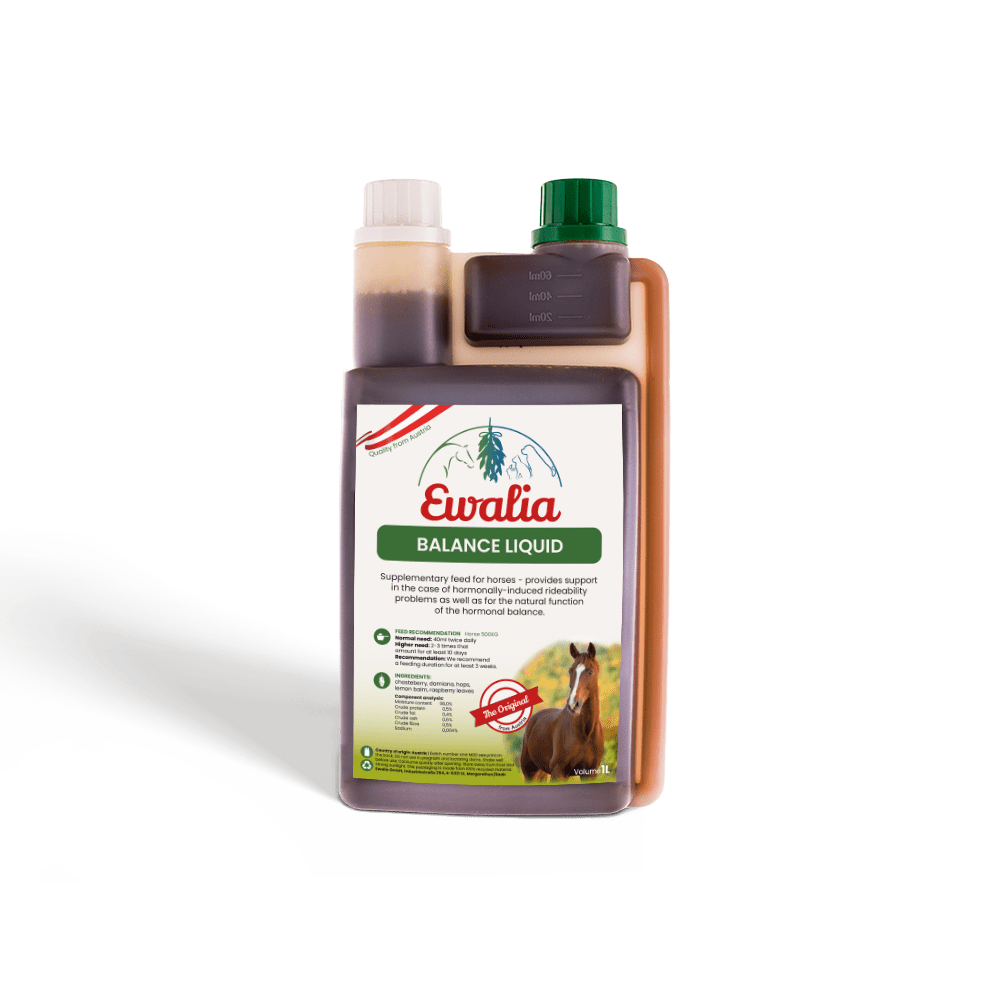EMS in horses

With horses, our good intentions can often backfire: chubby horses and roly-poly Thelwell ponies have become a common sight in stables. But obesity and lack of exercise are often the causes for serious metabolic disorders. Topping the list is EMS, or Equine Metabolic Syndrome – a disruption of the horse's carbohydrate metabolism which can have serious consequences, including dreaded laminitis. In EMS, often referred to as "equine diabetes", the horse's organism develops a resistance to insulin, the hormone responsible for breaking down sugar. Learn here about the symptoms of EMS and how you can protect your horse from complications arising from the disease.
What is EMS?
Equine Metabolic Syndrome is an endocrine (hormonal) disease that mostly affects overweight horses. It is associated with typical fat deposits, insulin resistance and a high risk of laminitis. EMS is frequently referred to as "equine diabetes" and compared to type 2 diabetes in humans, a disease which is also marked by insufficient insulin.
Especially susceptible horses include easy doers such as ponies, PRE horses, Fjord horses and Arabians. However, it can also affect large horses that consume too much energy in their feed.
The reasons lie in the history of the horse's development. Robust horse breeds are optimally suited for areas with sparse vegetation and large fluctuations in temperature. Such breeds often needed to cover extensive ground to fill their stomachs. The excess energy from young grass growth in spring helped newborn foals and reproduction, and any fat reserves from autumn were used up in winter.
Today's horses, however, enjoy a life of plenty. We protect them from the elements and rug them in winter. We provide them with high-quality roughage year-round and supplement this with concentrate feed to offset any deficiencies – or maybe just because they like the taste so much. We like our horses to be "cuddly" and may find those with normal weights to be too thin. Compared to their ancestors, who covered many kilometres each day in the pursuit of nourishment, our horses barely move – even on large pastures. Together with genetic and environmental factors, this combination of insufficient physical activity and excess feed – from an early age – predisposes a horse to EMS.
EMS is treatable. The earlier the disease is detected, the better the prognosis, because serious complications like laminitis and kidney failure can be prevented through adjustments to the horse's feed and management.
What are the symptoms of a horse with EMS?
EMS mostly affects horses between ages 5 and 15 that were overweight in the past and have difficulty losing weight even when they are fed reduced amounts of feed. Using the Body Condition Scoring of 1 to 9, horses susceptible to EMS will have a score of 7: clear ridges above the spinous processes of the back; the ribs can still be felt but a layer of fat can be felt as well; soft fat deposits at the dock of the tail; visible fat deposits at the crest of the mane, behind the shoulders and at the withers.
EMS horses will have pronounced fat deposits above the eyes, on the crest, shoulders, barrel, around the penis or udder, and at the tail head. EMS horses suffer from hunger pangs, may drink excessively and thus urinate more. Their obesity makes them susceptible to circulatory problems and respiratory ailments. Their insulin resistance may lead to kidney problems. They are at risk of developing colics due to the increased formation of fatty deposits (lipomas) in the abdominal cavity. Mares may experience changes to their reproductive cycle.
The most dreaded symptom is the gradual development of laminitis, which is often not recognised as such but can develop into both an acute and chronic condition at any time. The suspicion that a horse may have developed EMS often follows an unexplained episode of laminitis. However, a metabolism imbalance can be determined long beforehand through laboratory tests.
Not every overweight horse will develop EMS, and some EMS horses are thin. The first signs are increased appetite and diminished performance. The horse is susceptible to infections and may seem stiff and lethargic. It will have trouble building adequate muscle – which, however, can have many causes.
How does carbohydrate metabolism function in a healthy horse?
Sugar is produced through the digestion of starch contained in the horse's concentrate feed as well as in carbohydrates in pasture grass and hay, and enters the bloodstream via the small intestine. The breakdown of cellulose in the large intestine forms fatty acids that are converted into blood sugar in the liver. When the horse consumes feed, the blood sugar level rises, whereby easily digestible carbohydrates from grains, fruit, vegetables, or treats cause a rapid rise whilst the rise from roughage is slower and smaller. The equine organism is designed for long feeding periods and low-energy forage and thus can regulate a slow increase in blood sugar, but a rapid increase puts strain on the metabolism.
As soon as the blood sugar increases, the pancreas reacts by releasing insulin which stimulates the liver cells and the muscles to take in sugar as energy from the blood. This causes the blood sugar level of a healthy horse to fall, and the system stays in balance.
What occurs in EMS?
Leptin resistance in EMS: When a horse overeats, it first accumulates fat. The fatty tissue produces leptin, a hormone that acts as a natural feed brake by reducing feelings of hunger. This keeps well-nourished horses in the wild from eating more than they need. But when we offer our long-sated or even already-overweight horses extra feed, especially in the form of tasty concentrates, they won't say no! If the horse consumes more energy than it needs, the body will develop even more fatty tissue and release more and more leptin until the organism no longer reacts, i.e., it becomes resistant. Without the regulating effect of leptin, the horse will feel hungry constantly. This in turn will affect the already-too-high blood sugar levels which could normalise during intervals between feeding. Leptin resistance therefore leads to insulin resistance, which in turn leads to further obesity.
Insulin resistance in EMS: A constant surplus of blood sugar that remains high due to a lack of exercise will cause the muscles to be unable to absorb sugar – the reserves are full. The sugar remains in the bloodstream, and the pancreas keeps releasing more insulin. The result is that the cells no longer react to insulin because it is constantly present: the body is insulin resistant. This means that the cells which would burn sugar are no longer supplied with sufficient energy, even when there is more than enough sugar circulating in the bloodstream. The fatty tissue, however, is well supplied, which means more fat accumulation. Studies on EMS have found that horses must be overweight for some time before they develop insulin resistance. This explains why horses under five years of age do not show signs of PMS.
It is not yet clear why some thin horses also develop insulin resistance. It is suspected that an over-active insulin response to certain foods or high endocrine activity in the abdominal fat is to blame.
A study recently published in the USA shows that endocrine disruptors consumed by the horse in the feed contribute to the development of EMS. These agents, which can disrupt the horse's hormonal balance, are found in some synthetic materials. However, as the researchers point out, exposure to toxic agents varies greatly by region, and must be considered in the context of other factors like management conditions, nutrition, and physical activity.
Furthermore, a study on the heritability of EMS showed, surprisingly, 80% heritability of relevant metabolic features of the disease, especially in association with insulin.
What is pseudo-EMS?
Unlike EMS, in which fat pads form in specific areas, horses affected by pseudo-EMS appear obese and quite bloated all over. This is caused by fluid retention in the neck, shoulder, and flank regions. The horse may even have oedemas on its legs.
This condition particularly effects draught horses and baroque horses of all ages, and leisure horses more frequently than sport horses. Pseudo-EMS is also a consequence of metabolic disorders caused by feed. It is triggered by rapidly digestible carbohydrates, acidic feeds, or preserving agents and is associated with insulin resistance. Affected horses often suffer from persistent diarrhoea or renal insufficiency.
Why are EMS horses so susceptible to laminitis?
High blood sugar levels are thought to contribute to the development of laminitis because of their haemodynamic effects. "Sluggish" blood and poor circulation may lead to local infarctions in the hoof capillaries, causing laminitis. In addition, insulin can cause blood vessels to constrict, meaning that high insulin doses can provoke laminitis even in healthy horses.
The rapid increase of certain sugars from pasture grass is a frequent cause of laminitic episodes in EMS horses. The levels of monosaccharides, starches, and fructans in grass vary depending on its location, soil, the climate, and the time of day, and fluctuate constantly. Insulin-resistant horses have stronger reactions to changes in pasture grass content than do healthy animals. In general, feed changes which would not affect a healthy horse can lead to an attack of laminitis in an EMS horse, as it is constantly "on the tipping point" – both obesity and insulin resistance fuel inflammation and promote the production of oxygen free radicals.
An attack of laminitis heightens the problem even further, as laminitis is an extremely painful condition. This pain causes stress, which the organism tries to combat by releasing the stress hormone cortisol, the body's natural form of cortisone. However, a side effect of cortisol is insulin resistance.
How is EMS diagnosed?
To determine whether a horse has EMS, a blood sample is taken and its insulin and glucose levels are examined. Unfortunately, these tests are not always conclusive nor easy to carry out in practice. The values may be wrong if the horse becomes agitated or eats something it shouldn't before the blood sample is taken.
Before being tested for fasting insulin and glucose values, the horse may not consume any feed with rapidly digestible carbohydrates for 12 hours. A blood sample is taken in the morning to determine the horse's insulin and glucose levels. High readings suggest EMS, but low readings do not rule out insulin resistance entirely. Note: A horse currently experiencing laminitis or stress will always have higher values!
Glucose tolerance test: For this test, a blood sample is taken to determine basal glucose levels. The horse is then given an infusion of glucose. Further samples are taken at 30-minute intervals to determine the time needed to break down the glucose.
Caution: If the horse is already insulin resistant, this extra glucose may trigger laminitis! This test should be carried out in a veterinary clinic.
Combined glucose insulin test: After the basal glucose level is determined, the horse is given an infusion of glucose and an insulin injection immediately following. Samples are then taken at 10-minute intervals for a precise determination of insulin resistance.
Caution: An injection of insulin may result in hypoglycaemia. This test ideally should also be carried out in a veterinary clinic.
My horse has EMS – what now?
First, the most important thing: your horse needs to lose weight! However, radical diets should be avoided at all costs, as these can cause hyperlipidemia. Hyperlipidemia is when the body mobilises fat reserves stored in the liver and blood, and can be fatal. Ponies' bodies especially have strong reactions to sudden changes in their diets.
The second cornerstone for successful treatment of EMS is regular exercise to reduce fat reserves and restore insulin sensitivity to the muscle cells. If the horse does not suffer from laminitis, interval training is a particularly good method for slimming down. If the horse is not fit enough to be ridden, it can be brought to a large run-off area with interesting diversions, which will encourage the horse to move about.
Overweight horses will have quite different reactions to weight reduction programmes, so the details must correspond to the individual horse. Some horses will lose quite a bit of weight within three months of beginning their diet and exercise programme. Others start off much more slowly. A loss of about 30 or 40 kg in 4 to 6 weeks is a realistic goal; patience is therefore required. Another consideration is that horses with EMS will have a tendency to gain weight their whole lives.
What are important factors in feeding an EMS horse?
In order for a horse to slim down, its energy supply must be slowly reduced. Over-mature or late-cut, low-fructan hay has less energy than leafy hay. If necessary, the hay can be mixed with straw or soaked in water to "wash out" the sugar. The horse should not be fed haylage or silage, which contain too much energy. As a rule of thumb, the horse that needs to slim down may be given 1.5 to 2 kg of low-fructan hay per 100 kg target body weight daily. Feeding times can be lengthened through the use of a slow-feeder hay net.
Lush green pastures are taboo for the horse, but some EMS horses may be given limited turnout on pastures with over-mature grasses or which have already been grazed. Keep in mind that many horses will gorge themselves on grass if permitted only short grazing periods, thereby consuming more than if they'd been given more time at pasture! Especially quick eaters may be fed short grasses by hand as an alternative.
Feeds containing sugar – commercial feeds, apples, carrots, beet pulp or treats – are strictly forbidden! Avoid cereals with easily digestible carbohydrates and reduce the amount of protein and fat in the feed. The horse's protein needs can be covered through grass pellets.
Make sure the horse receives an adequate supply of vitamins and minerals if the hay is watered and turnout is restricted. The Freie Universität Berlin is currently carrying out research on whether additional magnesium could help EMS horses. Chromium yeast and grapefruit seed extract have also proven successful in cases of insulin resistance. Positive effects have been recorded through feeding psyllium, spirulina, or antioxidant grape seed extract as well.
Willow bark and meadowsweet have anti-inflammatory and analgesic effects in laminitis treatment due to their salicylic acid content. Fresh rosemary can also help promote insulin sensitivity.
Which herbs can I use to support my EMS horse?
Along with diet and exercise, herbs can benefit EMS horses by assisting in detoxification of the stressed organism. Herbs that contain bitter substances increase the flow of gastric juices and support detoxification through the liver. Diuretic herbs help to eliminate toxins over the kidneys.
But above all, the liver and kidneys must be protected so that they can handle the metabolic imbalance! Insulin resistance increases the risk of kidney diseases. The horse's liver will also be heavily strained from toxins while the body burns off fat. Unfortunately, liver and kidney overload will not turn up in blood analyses until these organs are already severely damaged. However, an observant horse owner can recognise possible warning signs!
Milk thistle fruits promote and protect the liver. It contains silymarin which helps to stabilise the liver cells and protect them from invasion by toxins. This substance also helps to speed up regeneration of the liver following damage. Studies indicate that milk thistle fruits can slow down the progression of fatty liver disease.
Birch leaves and stinging nettle boost detoxification via the kidneys and help the organism to flush out harmful substances. Stinging nettle also has anti-inflammatory properties.
The bitter substances in dandelion leaf and dandelion root promote liver metabolism. Dandelion has diuretic properties as well.
Sources and further reading
- Fritz, C., & Maleh, S. (2016). Zivilisationskrankheiten des Pferdes. Thieme.
- horse, t. (11. November 2017). thehorse.com. Von Does Spirulina Benefit Horses With EMS?: https://thehorse.com/148797/does-spirulina-benefit-horses-with-ems/ abgerufen
- horse, t. (14. Februar 2019). thehorse. Von Study: Endocrine Disrupting Chemicals Linked to EMS in Horses: https://thehorse.com/166842/study-endocrine-disrupting-chemicals-linked-to-ems-in-horses/ abgerufen
- Kunze, J. N. (2012). Bakkalaureatsarbeit. Fettleibigkeit beim Pferd. Wien: Vet. Med. Uni Wien.
- Laboklin. (März 2011). Labor für klinische Diagnostik. Von Endokrinopathien beim Pferd: https://laboklin.com/de/laboklin-aktuell/newsdetails/article/endokrinopathien-beim-pferd/ abgerufen
- Norton, E., Schultz, N., Rendahl, A., Mcfarlane, D., Geor, R., Mickelson, J., & McCue, M. (Juli 2019). Heritability of metabolic traits associated with equine metabolic syndrome in Welsh ponies and Morgan horses. Equine Veterinary Journal, S. 475-480.
- Winter, J. C. (21. Juli 2020). Dissertation. Intracellular magnesium concentration in healthy horses and horses with insulin dysregulation. Berlin: Mensch und Buch Verlag.
















